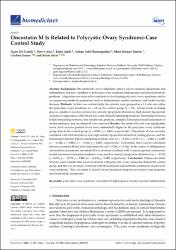| dc.description.abstract | Background: Oncostatin M, a novel adipokine, plays a role in oogenesis, lipogenesis, and inflammation and may contribute to polycystic ovary syndrome pathogenesis and related metabolic problems. Adipokines are believed to contribute to developing polycystic ovary syndrome and its accompanying metabolic parameters, such as dyslipidemia, insulin resistance, and cardiovascular diseases. Methods: In this case–control study, the patients were grouped in a 1:1 ratio into either the polycystic ovary syndrome (n = 32) or the control group (n = 32). Serum levels of fasting glucose, insulin, C-reactive protein, low-density lipoprotein cholesterol, high-density lipoprotein cholesterol, triglyceride, white blood cell count, thyroid-stimulating hormone, luteinizing hormone, follicle-stimulating hormone, total testosterone, prolactin, estradiol, homeostasis model assessment of insulin resistance, and oncostatin M were analyzed. Results: Oncostatin M levels were significantly lower, but C-reactive protein levels were substantially higher in the polycystic ovary syndrome group than in the control group (p = 0.002, p = 0.001, respectively). Oncostatin M was inversely correlated with total cholesterol, non-high-density lipoprotein cholesterol, fasting glucose, and the luteinizing hormone/follicle-stimulating hormone ratio (ρ = −0.329, p =0.017; ρ = −0.386, p = 0.005; ρ = −0.440, p = 0.001; ρ = −0.316, p = 0.023, respectively). Conversely, there was no correlation between oncostatin M and total testosterone level (ρ = 0.220; p = 0.118). In the context of inflammation and metabolic parameters, oncostatin M was inversely correlated with C-reactive protein, homeostatic model assessment for insulin resistance score, and low-density lipoprotein cholesterol (ρ = −0.353, p = 0.019; ρ = −0.275, p = 0.048; ρ = −0.470, p < 0.001, respectively). Conclusions: Plasma oncostatin M levels were considerably lower in patients with polycystic ovary syndrome than in the control group, and this was inversely correlated with the hormonal and metabolic parameters of polycystic ovary syndrome. Thus, oncostatin M may be a novel therapeutic target for polycystic ovary syndrome and its metabolic parameters. | en_US |




















